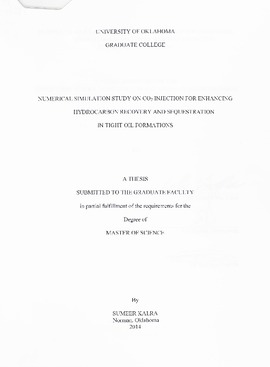| dc.contributor.advisor | Wu, Xingru | |
| dc.contributor.advisor | Devegowda, Deepak | |
| dc.contributor.advisor | Pournik, Maysam | |
| dc.creator | Kalra, Sumeer | |
| dc.date.accessioned | 2018-11-21T22:29:30Z | |
| dc.date.available | 2018-11-21T22:29:30Z | |
| dc.date.issued | 2014 | |
| dc.identifier.citation | Kalra, S. (2014). Numerical Simulation Study on CO2 Injection for Enhancing Hydrocarbon Recovery and Sequestration in Tight Oil Formations / by Sumeer Kalra. | |
| dc.identifier.uri | https://hdl.handle.net/11244/302146 | |
| dc.description.abstract | Hydrocarbon resources from unconventional reservoirs, especially tight/shale plays, are changing the North America's energy prospect. Single digit percentage of oil shale recovery with current best practices, leaves a large room for recovery improvement. While aqueous phase injection into tight formation is extremely challenging, other recovery techniques need to be evaluated and pilot tested for secondary recovery in oil shale reservoirs. Injecting Carbon Dioxide (CO2) into oil shale formations can potentially improve oil recovery. Furthermore, the large surface area in the organic rich shale could permanently store CO2 volume without jeopardizing the formation integrity. | |
| dc.description.abstract | This work is a study on evaluating the effectiveness of CO2 enhanced oil shale recovery and shale formation CO2 sequestration capacity. The work identified the most favorable reservoir properties and operating envelop for field application of CO2-EOR in tight formations. A compositional reservoir simulator is used to model CO2 injection in a tight / oil shale reservoir. Formation and petrophysical properties, and reservoir fluid composition of the Middle Bakken formation is used to set up the base model for simulation. For investigating the technical feasibility of increasing oil production by CO2 injection, a sector of Parshall field from Bakken formation is modeled with two active wells. The reservoir model considered petrophysical characteristics of tight formation that affects CO 2 flow migration such as (1) reservoir heterogeneity (2) in-situ stress change (geomechanical) impact on permeability of natural fracture networks and hydraulic fractures during simultaneous injection and production, (3) impact of adsorption and diffusion on carbon storage in organic rich shale, (4) presence of natural fractures, secondary fracture geometry and connectivity, fracture density and orientation effect. The results are based on sensitivity analysis of the characteristic tight formation petrophysical, geomechanical properties and displacement mechanisms. Sensitivity analysis also focused on injection schemes and completion practices for most economic field applications. Sensitivity analysis is implemented by two methods. First method analyzed each uncertain parameter individually and reproduced the results in terms of a tornado chart, defining the critical parameters . Second method analyzed all uncertain parameters together using the Design of Experiment (DoE) and Response Surface Modeling (RSM) approach to counter the interaction between parameters and influential parameters into generating a proxy model for optimizing oil recovery and CO2 injection into the formation. | |
| dc.description.abstract | The results show that facilitating oil recovery from shale reservoirs by CO2 injection is much higher than primary depletion depending on fracture network connectivity. This research outlines the capabilities of CO2 injection for improving oil production from unconventional reservoirs. Also, significant CO2 storage capacity, if applicable in shale formations, could be a major step towards advances in CO2 sequestration in widely spread shale reservoirs. | |
| dc.format.extent | 198 pages | |
| dc.format.extent | 57,964,671 bytes | |
| dc.format.medium | application.pdf | |
| dc.language | en_US | |
| dc.subject | Oil fields -- Production methods | |
| dc.subject | Hydrocarbon reservoirs -- Mathematical models | |
| dc.subject | Carbon sequestration | |
| dc.subject | Enhanced oil recovery | |
| dc.subject | Mewbourne School of Petroleum and Geological Engineering | |
| dc.title | Numerical simulation study on CO2 injection for enhancing hydrocarbon recovery and sequestration in tight oil formations | |
| dc.type | text | |
| ou.group | Mewbourne College of Earth and Energy::Mewbourne School of Petroleum and Geological Engineering | |
